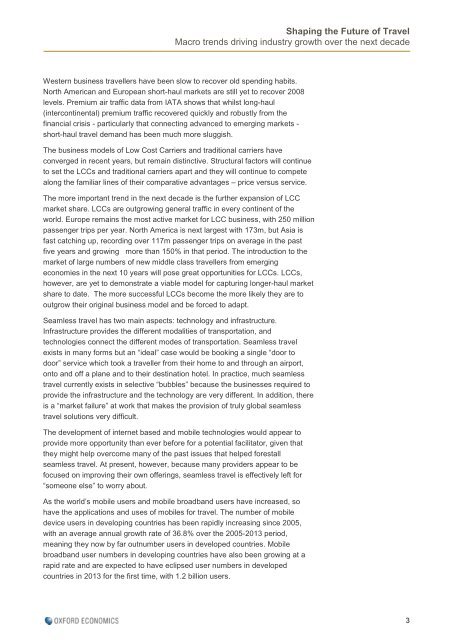Amadeus-Shaping-the-Future-of-Travel-MacroTrends-Report
Amadeus-Shaping-the-Future-of-Travel-MacroTrends-Report
Amadeus-Shaping-the-Future-of-Travel-MacroTrends-Report
Create successful ePaper yourself
Turn your PDF publications into a flip-book with our unique Google optimized e-Paper software.
<strong>Shaping</strong> <strong>the</strong> <strong>Future</strong> <strong>of</strong> <strong>Travel</strong><br />
Macro trends driving industry growth over <strong>the</strong> next decade<br />
Western business travellers have been slow to recover old spending habits.<br />
North American and European short-haul markets are still yet to recover 2008<br />
levels. Premium air traffic data from IATA shows that whilst long-haul<br />
(intercontinental) premium traffic recovered quickly and robustly from <strong>the</strong><br />
financial crisis - particularly that connecting advanced to emerging markets -<br />
short-haul travel demand has been much more sluggish.<br />
The business models <strong>of</strong> Low Cost Carriers and traditional carriers have<br />
converged in recent years, but remain distinctive. Structural factors will continue<br />
to set <strong>the</strong> LCCs and traditional carriers apart and <strong>the</strong>y will continue to compete<br />
along <strong>the</strong> familiar lines <strong>of</strong> <strong>the</strong>ir comparative advantages – price versus service.<br />
The more important trend in <strong>the</strong> next decade is <strong>the</strong> fur<strong>the</strong>r expansion <strong>of</strong> LCC<br />
market share. LCCs are outgrowing general traffic in every continent <strong>of</strong> <strong>the</strong><br />
world. Europe remains <strong>the</strong> most active market for LCC business, with 250 million<br />
passenger trips per year. North America is next largest with 173m, but Asia is<br />
fast catching up, recording over 117m passenger trips on average in <strong>the</strong> past<br />
five years and growing more than 150% in that period. The introduction to <strong>the</strong><br />
market <strong>of</strong> large numbers <strong>of</strong> new middle class travellers from emerging<br />
economies in <strong>the</strong> next 10 years will pose great opportunities for LCCs. LCCs,<br />
however, are yet to demonstrate a viable model for capturing longer-haul market<br />
share to date. The more successful LCCs become <strong>the</strong> more likely <strong>the</strong>y are to<br />
outgrow <strong>the</strong>ir original business model and be forced to adapt.<br />
Seamless travel has two main aspects: technology and infrastructure.<br />
Infrastructure provides <strong>the</strong> different modalities <strong>of</strong> transportation, and<br />
technologies connect <strong>the</strong> different modes <strong>of</strong> transportation. Seamless travel<br />
exists in many forms but an “ideal” case would be booking a single “door to<br />
door” service which took a traveller from <strong>the</strong>ir home to and through an airport,<br />
onto and <strong>of</strong>f a plane and to <strong>the</strong>ir destination hotel. In practice, much seamless<br />
travel currently exists in selective “bubbles” because <strong>the</strong> businesses required to<br />
provide <strong>the</strong> infrastructure and <strong>the</strong> technology are very different. In addition, <strong>the</strong>re<br />
is a “market failure” at work that makes <strong>the</strong> provision <strong>of</strong> truly global seamless<br />
travel solutions very difficult.<br />
The development <strong>of</strong> internet based and mobile technologies would appear to<br />
provide more opportunity than ever before for a potential facilitator, given that<br />
<strong>the</strong>y might help overcome many <strong>of</strong> <strong>the</strong> past issues that helped forestall<br />
seamless travel. At present, however, because many providers appear to be<br />
focused on improving <strong>the</strong>ir own <strong>of</strong>ferings, seamless travel is effectively left for<br />
“someone else” to worry about.<br />
As <strong>the</strong> world’s mobile users and mobile broadband users have increased, so<br />
have <strong>the</strong> applications and uses <strong>of</strong> mobiles for travel. The number <strong>of</strong> mobile<br />
device users in developing countries has been rapidly increasing since 2005,<br />
with an average annual growth rate <strong>of</strong> 36.8% over <strong>the</strong> 2005-2013 period,<br />
meaning <strong>the</strong>y now by far outnumber users in developed countries. Mobile<br />
broadband user numbers in developing countries have also been growing at a<br />
rapid rate and are expected to have eclipsed user numbers in developed<br />
countries in 2013 for <strong>the</strong> first time, with 1.2 billion users.<br />
3


